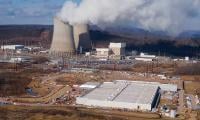LAHORE: The federal government has allowed replacement of Floating Storage & Regasification Unit (FSRU) without any taxation burden in a bid to fast-track the installation of new Liquefied Natural Gas (LNG) terminals in the country, The News has learnt on Thursday .
The move, which is a part of efforts relating to increasing energy security, will pave the way for facilitating new investors in setting up LNG terminals on expeditious basis as one of their main concerns regarding early sourcing of FSRU would be alleviated.
With adjustment of taxes, the prospective investors will now be able to set up terminal with quickest available FSRUs from the market without waiting for build-to-order FSRU. The Custom Duty, which is payable at the time of import of the quickest available vessel, can be adjusted on the later import of specific FSRU.
Moreover, the management of the LNG terminals will be able to temporarily replace FSRU for up to 180 days in order to carry out repair and maintenance work in case of facing challenge of machinery breakdown, accidents, or similar unforeseen situation.
According to latest policy measure, the Federal Board of Revenue (FBR) will not charge duty or sales tax on the temporarily imported floating storage and regasification unit of the LNG terminal for a period of 180 days for use in place of a primary unit.
Setting up of LNG terminal on fast-track has been termed the only hope to narrow the supply gap as burgeoning demand-supply imbalance has become a permanent nuisance, haunting consumers almost throughout the year. During ongoing summer, the government had to reduce Regasified Liquefied Natural Gas (RLNG) quota of industry under a mutually agreed arrangements with a view to increase power generation to meet peak electricity load.
The gas shortage in the country has already led the economic coordination committee of the cabinet (ECC) to approve the implementation/construction of the 3rd terminal at the PQA. The said amendments will go a long way in fast-tracking this vital energy-related development.
Such novel regulatory initiative is needed to set up LNG terminal as soon as possible to bridge widening gap in natural gas demand and supply. Winter shortfall may hit consumers hard as initiation of work on third LNG import terminal delayed due to one reason or the other. Pakistan’s third LNG import terminal could have been up and running in the third quarter of 2019-20, well before the onset of winter, had its construction been commenced earlier last year, said an industry source. Following breaking years of impasse with the back-to-back installation of two terminals, having LNG import capacity of 1.2 billion cubic feet per day (BCFD), unfortunately work on the third could not be initiated despite a growing shortfall of natural gas.
As a relatively new source of energy, the RLNG has been playing a pivotal role in the primary energy mix of Pakistan since early 2015 with the opening of import window. So far, the country has imported about 12 million tons of the LNG, providing natural gas into the national network. However, at times, gaps in the LNG supply chain led to shutting down gas deliveries to various consumer categories, including power plants, industry, and transport sectors for an indefinite period. Such a precarious supply chain exposed the vulnerability of the country’s energy security as gaps in the LNG import caused widespread shortage of natural gas, especially in the winter months.
The reduction of natural gas share in energy mix prior to imports attributed to declining natural gas reserves. However, following construction of the LNG terminals, the share of imported LNG has increased from 0.7 percent in FY2015 to 8.7 percent in FY2018. Consequently, share of the RLNG has shown a tremendous growth in energy mix as it served the demand of consumers, including various power plants as well as that of fertiliser plants and industrial and transport sector. To mitigate gas demand-supply shortfall, there has been gradual increase in import of LNG which resulted in improving average natural gas consumption to 3.86 billion cubic feet per day (bcfd), including 0.78 bcfd of RLNG during July 2018 to February 2019.















